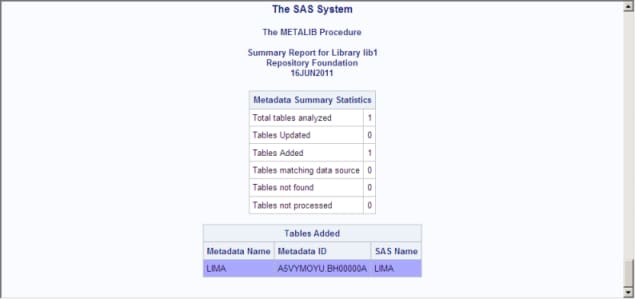Updating Your Table Metadata to Match Data in Your Physical Tables
Adding and Updating Table Metadata
Example: Default PROC METALIB Behavior
The following example
uses the default PROC METALIB behavior. Summary notes are written
to the SAS log regardless of whether you request a report. Unlike
the example shown in Assessing Potential Changes in Advance, the summary does not mention any
deleted tables.
proc metalib; omr (library="lib1" repname="Foundation" ); run;
Without the REPORT statement,
the options are written to the SAS log. The output resembles the following
example:.
105 proc metalib;
106 omr (library="lib1" repname="Foundation" );
107 run;
NOTE: A total of 3 tables were analyzed for library "lib1".
NOTE: Metadata for 2 tables was updated.
NOTE: Metadata for 1 tables was added.
NOTE: Metadata for 0 tables matched the data sources.
NOTE: 0 other tables were not processed due to error or UPDATE_RULE.
NOTE: PROCEDURE METALIB used (Total process time):
real time 0.20 seconds
cpu time 0.06 secondsChanging the Update Rule
By using the optional UPDATE_RULE statement, you can
change the default behavior of PROC METALIB. The principal rules that
you can specify are shown as follows:
Example: Adding, Updating, and Deleting Metadata
The following example
shows how to use PROC METALIB to add metadata for new tables, update
table definitions where necessary, and also delete table definitions
that are no longer valid. (You can also perform these functions using
SAS Data Integration Studio.)
proc metalib; omr (library="lib1" repname="Foundation" ); update_rule=(delete); report; run;
The following example
shows how to use UPDATE_RULE with DELETE, NOADD, and NO UPDATE to
delete table definitions that are no longer valid, as well as suppress
the default add and update actions:
proc metalib; omr (library="lib1" repname="Foundation" ); update_rule (delete noadd noupdate); report; run;
Specifying Which Tables Are Affected
You can use the optional SELECT or EXCLUDE statements
to perform an operation against a subset of the tables in a library.
SELECT and EXCLUDE are mutually exclusive, so you should use only
one or the other.
-
For tables, specify their SAS name. If no table definition is found in metadata, it is created in the repository that contains the library object. If a matching table definition is found in metadata, it is compared to the physical table. If differences are found, the table definition is updated in metadata.

